Abb TPS61-R35 User Manual

Operation Manual
TPS61-R35
HT594627 English
Original Operation Manual
Chapter |
Document-ID |
1 Introduction
HZTL4005_EN_G
2 Safety
HZTL4027_EN_A
3 Safety data sheet |
HT594627 |
4 Product description
HZTL4042_EN_C
ABB Turbocharging
Operating limits and replacement intervals
The recommended replacement intervals and the corresponding operating limits in chapter 3 are jointly defined with the enginebuilder. This information is specific to the product.
Non-observance of the recommended replacement intervals and the operating limits increases the risk of unpredictable component failures.

Operation Manual / 1 Introduction
Table of contents
Introduction |
|
|
1 |
Introduction............................................................................................................ |
2 |
1.1 |
Purpose of the manual.................................................................................................. |
2 |
1.2 |
Symbols, definitions...................................................................................................... |
3 |
1.3 |
Storage of new turbochargers and spare parts ...................................................... |
5 |
1.4 |
Contact information...................................................................................................... |
7 |
© Copyright 2020 ABB. All rights reserved. |
HZTL4005_EN |
Rev.G |
March 2020 |
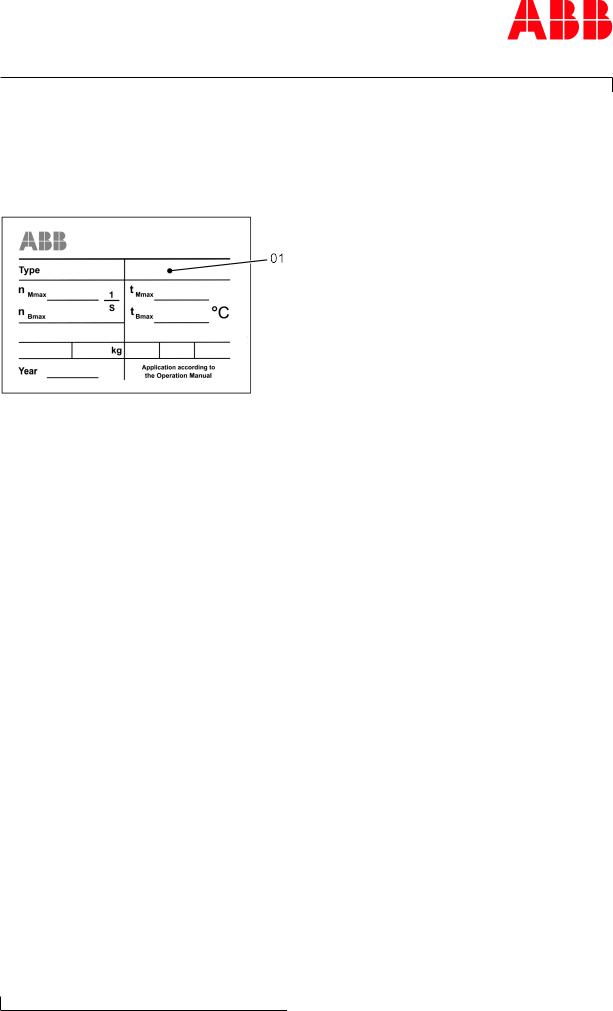
Operation Manual / 1 Introduction
1 Introduction / 1.1 Purpose of the manual
1 Introduction
1.1Purpose of the manual
Page 2 / 7
Fig. 1: Serial number (01) on the rating plate
This Operation Manual belongs to the turbocharger with the identical serial number (01), see chapter 3 (Safety data sheet) and the rating plate on the turbocharger.
Operation Manual
The Operation Manual explains the turbocharger and contains instructions for safe operation.
The Operation Manual is a complement to and expansion of existing national regulations for occupational safety, accident prevention and environmental protection.
Target group
The Operation Manual is aimed at engineers and trained mechanics responsible for the proper operation of the engine and for the turbocharger connected to it.
Availability of the Operation Manual
The Operation Manual must be available where the turbocharger is used.
All persons operating or working on the turbocharger must have read and fully understood the Operation Manual.
© Copyright 2020 ABB. All rights reserved. |
HZTL4005_EN |
Rev.G |
March 2020 |

Operation Manual / 1 Introduction
1 Introduction / 1.2 Symbols, definitions
1.2Symbols, definitions
Symbols
The following symbols are used in this document:
u Indicates an action step.
1. Indicates a numbered action step.
→ Refers to a page number
Definition of Note
NOTICE
Note
The note provides advice which facilitates the work.
Definition of mandatory signs
Mandatory signs show the protective equipment to be worn for a task. The mandatory signs are described in chapter Safety and must be complied with.
Definition of Caution / Warning
Caution and warning signs are described in chapter Safety.
ABB Turbocharging
ABB Switzerland Ltd, Turbocharging is identified as ABB Turbocharging or as ABB Turbo Systems in this document.
Official service stations of ABB Turbocharging
Official service stations are regularly audited and certified by ABB Turbocharging. See also chapter Contact information →7.
Page 3 / 7
© Copyright 2020 ABB. All rights reserved. |
HZTL4005_EN |
Rev.G |
March 2020 |
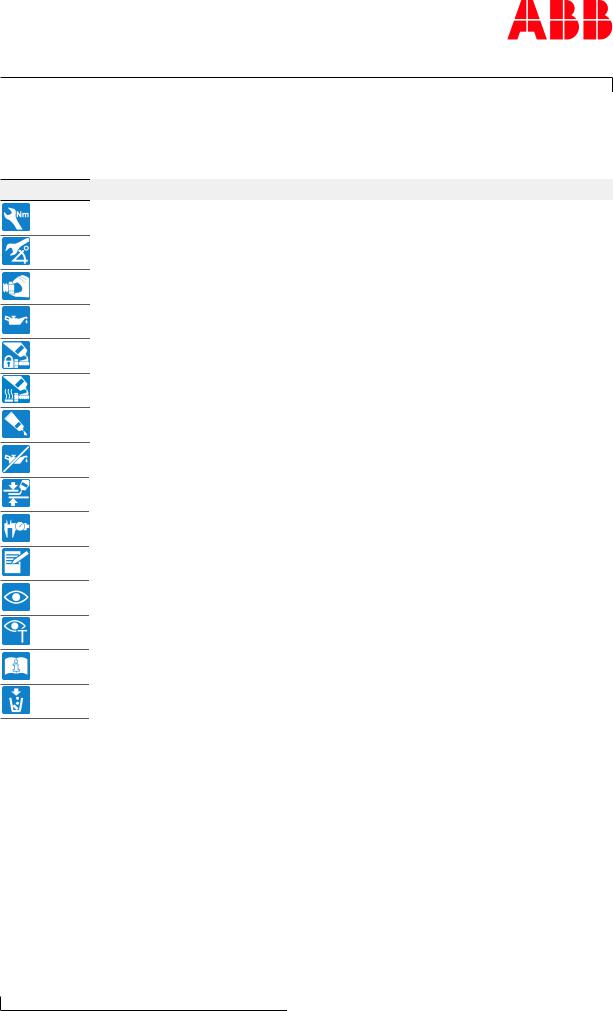
Page 4 / 7
Operation Manual / 1 Introduction
1 Introduction / 1.2 Symbols, definitions
Definition of pictograms
The following pictograms can occur in this document. These point out actions that must be taken in accordance with the meaning of the relevant pictogram.
Pictogram Meaning
Tighten with specified torque
Tighten over specified tightening angle
Hand-tight, tighten without tools
Oil
Apply screw locking paste (e.g. Loctite)
Apply high-temperature grease
Apply other paste in accordance with specifications
Oil free, grease free and dry
Affix
Measure
Note
Visually inspect
Please note text for numbered work step.
See document
Dispose of in an environmentally compatible, professional way and in compliance with locally applicable regulations.
Table 1: Definition of pictograms
© Copyright 2020 ABB. All rights reserved. |
HZTL4005_EN |
Rev.G |
March 2020 |
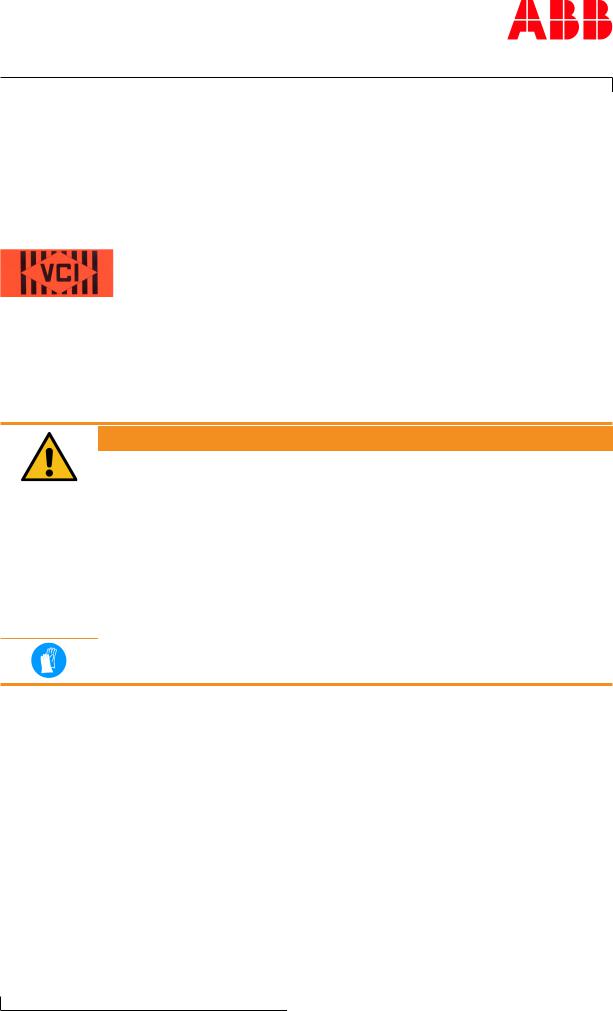
Operation Manual / 1 Introduction
1 Introduction / 1.3 Storage of new turbochargers and spare parts
1.3Storage of new turbochargers and spare parts
Storage of new turbochargers and spare parts up to 6 months
New turbochargers and spare parts can be stored in sealed packaging without additional mothballing measures for up to 6 months from the date of delivery (marked by the VCI label on the package).
Fig. 2: Volatile Corrosion Inhibitor (VCI)
Only dry rooms in which the relative humidity is between 40…70 % and no condensation can form are suitable for storage.
Storage of new turbochargers and spare parts for more than 6 months
 WARNING
WARNING
Protection of health when handling VCIs
VCI products are not hazardous in the sense of the Hazardous Substances Ordinance. Nevertheless, the following points are to be observed when handling VCIs:
uObserve specifications in the safety data sheet
uEnsure good room ventilation.
uDo not eat, drink or keep food at the workplace while working with VCIs.
uClean hands and face after working with VCIs.
uFor further information refer to www.branopac.com.
Wear safety gloves to protect against mechanical hazards.
The following mothballing measures are required every 6 months:
uOpen the package.
uRemove the VCI corrosion protection emitter from the package and replace it with a new, identical VCI corrosion protection emitter. New VCI corrosion protection emitters can be obtained at www.branopac.com.
uDispose of the old VCI corrosion protection emitter in an environmentally compatible manner, professionally and in accordance with local regulations.
uSeal the package. The better the external seal is designed, the more permanent the protection.
Page 5 / 7
© Copyright 2020 ABB. All rights reserved. |
HZTL4005_EN |
Rev.G |
March 2020 |
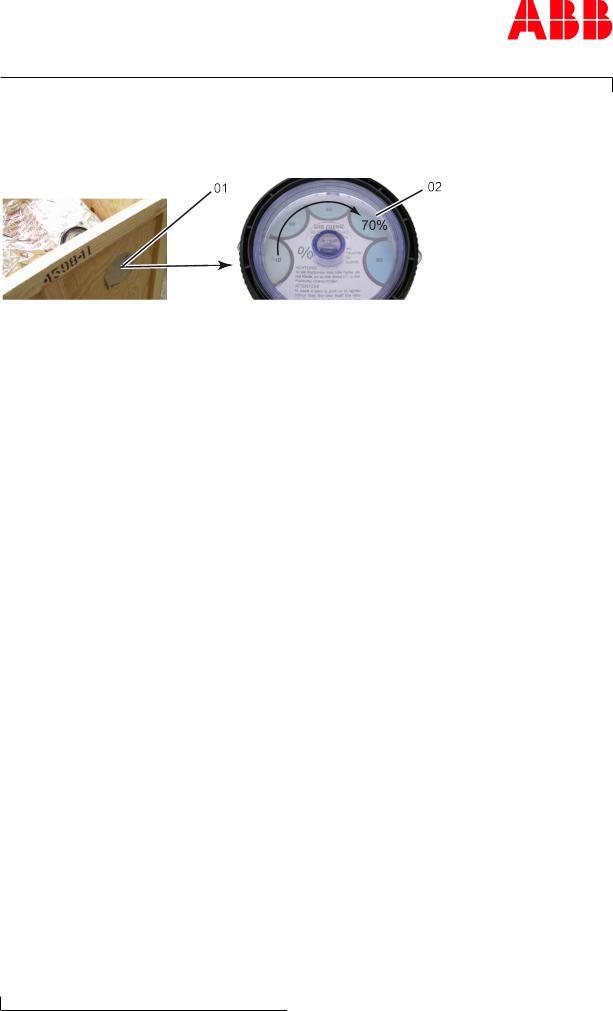
Operation Manual / 1 Introduction
1 Introduction / 1.3 Storage of new turbochargers and spare parts
Long-term storage of turbochargers
The turbochargers will be prepared for prolonged storage by ABB Turbo Systems on request. The package is equipped with a hygrometer (see illustration).
Page 6 / 7
Fig. 3: Package with hygrometer
The following measures are required every 6 months:
uCheck the hygrometer (02) in the sight-glass. There is an opening (01) in the wooden crate which allows this check to be carried out. When the display field has changed colour at the 70% level, the maximum permissible humidity has been exceeded. In this case the turbocharger must be inspected by an ABB Turbocharging Service Station and repacked.
uInspect the package for damage. If the package is damaged, the turbocharger must be inspected by an ABB Turbocharging Service Station and repacked.
After every 3 years the following work steps must be performed by an ABB Turbocharging Service Station:
¡Inspect the components
¡Replace the desiccant agent
¡Repackage the components.
If the 70% display field of the hygrometer (02) has not changed colour and the package is undamaged, the turbocharger can be placed into operation without any prior testing by an ABB Turbocharging Service Station.
Unpacking turbochargers
The corrosion protection effect ends after the material is unpacked from the VCI package.
To avoid the formation of condensation, the surroundings and the content of the package must have the same temperature during unpacking.
© Copyright 2020 ABB. All rights reserved. |
HZTL4005_EN |
Rev.G |
March 2020 |

Operation Manual / 1 Introduction
1 Introduction / 1.4 Contact information
1.4Contact information
Contact information for the ABB Turbocharging Service Stations is available online.
u Scan the QR code to access our website.
ABB Switzerland Ltd, Turbocharging
Bruggerstrasse 71a
CH-5401 Baden
Switzerland
www.abb.com/turbocharging
Page 7 / 7
© Copyright 2020 ABB. All rights reserved. |
HZTL4005_EN |
Rev.G |
March 2020 |

Operation Manual / 2 Safety / TPS-R
Table of contents
Safety |
|
|
1 |
Safety ...................................................................................................................... |
2 |
1.1 |
Introduction .................................................................................................................... |
2 |
1.2 |
CE conformity................................................................................................................. |
2 |
1.3 |
Definition of mandatory signs .................................................................................... |
3 |
1.4 |
Definition of safety instructions ................................................................................ |
3 |
1.5 |
Intended use .................................................................................................................. |
4 |
1.6 |
Warning plates on the turbocharger.......................................................................... |
5 |
1.7 |
Turbocharger rating plate........................................................................................... |
6 |
1.8 |
Lifting of loads .............................................................................................................. |
8 |
1.9 |
Prerequisites for operation and maintenance........................................................ |
9 |
1.10 |
Hazards during operation and maintenance ......................................................... |
10 |
1.11 |
Safe operation .............................................................................................................. |
12 |
1.12 |
Safe maintenance ........................................................................................................ |
13 |
© Copyright 2018 ABB. All rights reserved. |
HZTL4027_EN |
Revision A |
April 2018 |

Page 2 / 16
Operation Manual / 2 Safety / TPS-R
1 Safety / 1.1 Introduction
1 Safety
1.1Introduction
Turbochargers manufactured by ABB reflect the state of the art. The respective safety and health protection requirements are met. This ensures safe operation of the turbocharger. Nevertheless, there may be some residual risks during operation of and work on the turbocharger which:
¡Are caused by the turbocharger itself or its accessories.
¡Are caused by the operating equipment used or supplies and materials.
¡Are a consequence of insufficient compliance with safety instructions.
¡Are a consequence of insufficient or inappropriate performance of maintenance and inspection work.
The operating company is responsible for defining measures that regulate safe access to and safe handling of the turbocharger.
All instructions contained in this chapter must be observed for safe and trouble-free operation of the turbocharger and during all work on the turbocharger.
All further safety instructions contained and specifically identified in every chapter of this manual (Definition of safety instructions →3) must also be observed.
1.2CE conformity
Information
ABB turbochargers comply with the Machinery Directive 2006/42/EC and are partly completed machinery as defined by Article 2 g in this directive.
© Copyright 2018 ABB. All rights reserved. |
HZTL4027_EN |
Revision A |
April 2018 |
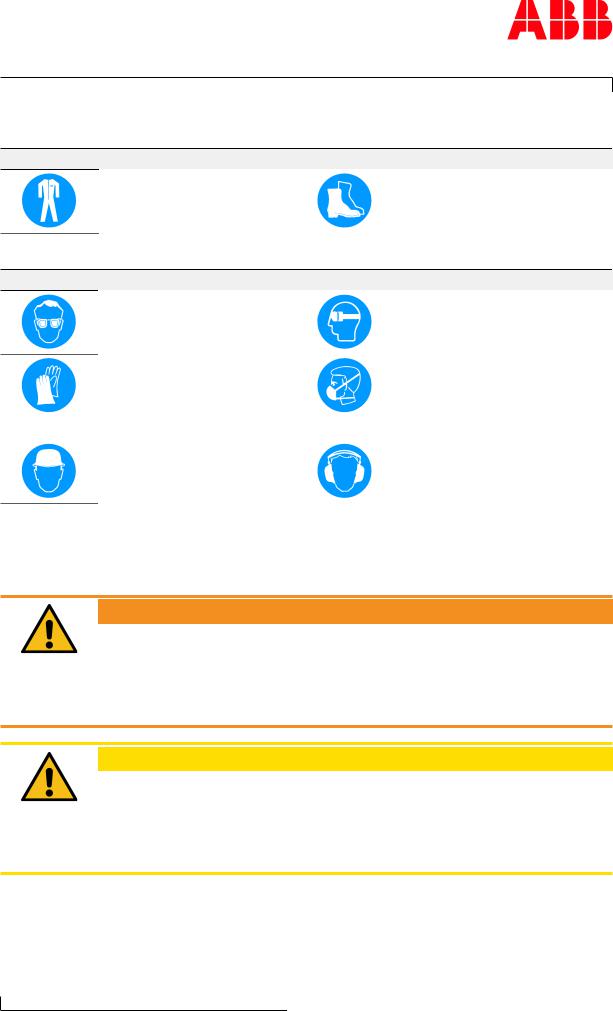
Operation Manual / 2 Safety / TPS-R
1 Safety / 1.3 Definition of mandatory signs
1.3Definition of mandatory signs
To be worn at all times
Protective clothing |
Safety footwear to protect |
|
against mechanical hazard and |
|
risk of falling |
Table 1: Personal protective equipment to be worn at all times
To be worn specific to the respective task
Safety glasses |
Safety goggles |
Safety gloves to protect |
Respiratory mask to protect |
against |
against |
- Mechanical hazard |
- Dusts |
- Chemical hazard |
- Gases |
- Thermal hazard |
|
- Electrical hazard |
|
Safety helmet |
Ear protection |
Table 2: Personal protective equipment to be worn specific to the respective task
1.4Definition of safety instructions
 WARNING
WARNING
Definition of Warning
Non-compliance or inaccurate compliance with working or operating instructions indicated by this symbol and the word WARNING can lead to serious injuries to personnel and even to fatal accidents.
u Warning signs must always be observed.
 CAUTION
CAUTION
Definition of Caution
Non-compliance or inaccurate compliance with working or operating instructions indicated by this symbol and the word CAUTION can lead to serious damage to engine or property with grave consequences.
u Caution signs must always be observed.
Page 3 / 16
© Copyright 2018 ABB. All rights reserved. |
HZTL4027_EN |
Revision A |
April 2018 |

Page 4 / 16
Operation Manual / 2 Safety / TPS-R
1 Safety / 1.5 Intended use
1.5Intended use
Use on internal combustion engines in general
ABB turbochargers are intended for charging internal combustion engines.
The turbocharger supplies the engine with the air volume or air/gas mixture and the associated charging pressure required for operation.
The turbocharger is solely intended to be operated with a clockwise direction of rotation as viewed from the turbine end.
The specific operating limits of the turbocharger were determined on the basis of information from the enginebuilder about the intended use. These data are given on the rating plate.
ABB accepts no liability and rejects all warranty claims for any non-intended uses.
 WARNING
WARNING
Unapproved operation
Any operation of the turbocharger outside of its operating limits can be hazardous to personnel.
uOnly operate the turbocharger within the operating limits.
uOnly trained personnel must operate the turbocharger.
The intended use of the turbocharger includes compliance with all regulations and conditions. In particular, the following must be observed:
¡Operation Manual
¡Instructions of the enginebuilder
State of the art
The turbocharger is designed and manufactured according to the state of the art and is safe to operate.
Perfect condition
The turbocharger must only be used when it is in a technically flawless condition and operated in compliance with its intended use.
ABB excludes any liability for damage resulting from unauthorized modifications to the turbocharger or improper operation.
© Copyright 2018 ABB. All rights reserved. |
HZTL4027_EN |
Revision A |
April 2018 |

Operation Manual / 2 Safety / TPS-R
1 Safety / 1.6 Warning plates on the turbocharger
1.6Warning plates on the turbocharger
Warning plates are attached to the turbocharger, which must be observed. The warning plates must always be present in the intended locations and must be legible.
Fig. 1: Warning plate
If warning plates are not present in the intended locations or are not legible, they must be replaced with new warning plates. The necessary information can be found in the Operation Manual, Chapter 4 Product description.
Turbochargers supplied to the enginebuilder without insulation must be equipped later with warning plates on the insulation. This is the responsibility of the enginebuilder.
Page 5 / 16
© Copyright 2018 ABB. All rights reserved. |
HZTL4027_EN |
Revision A |
April 2018 |
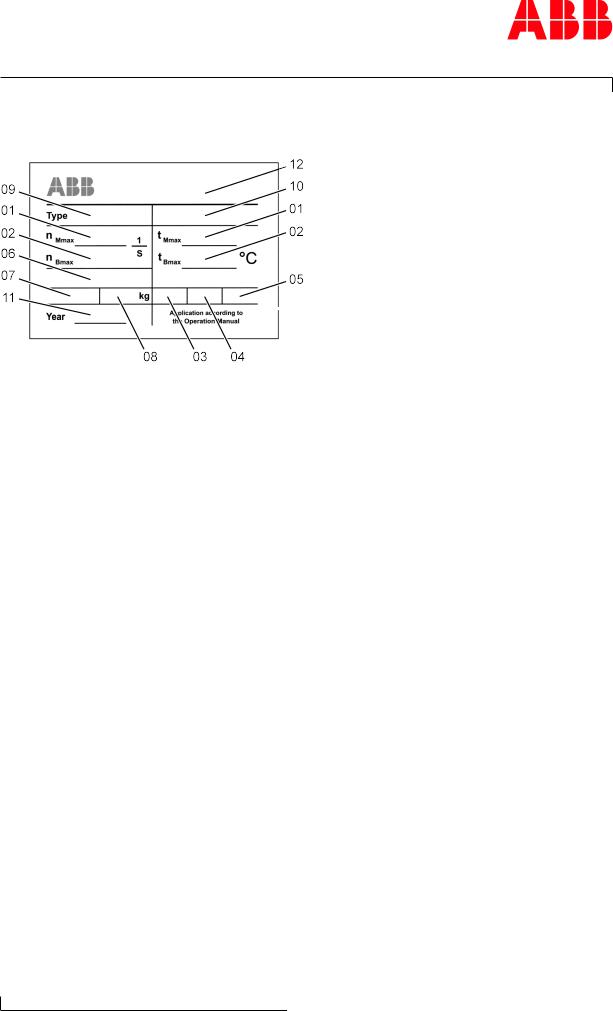
Operation Manual / 2 Safety / TPS-R
1 Safety / 1.7 Turbocharger rating plate
1.7Turbocharger rating plate
Page 6 / 16
Fig. 2: Rating plate
Operating limits
01Turbocharger operating limits at engine overload (110 %).
In test rig operation only, unless otherwise agreed with the enginebuilder.
02 Turbocharger operating limits during operation
Recommended inspection and replacement intervals of turbocharger components
03 Inspection interval of plain bearings in 1000 h
04 Replacement interval of compressor in 1000 h
05 Replacement interval of turbine in 1000 h
Further data
06 Customer part number
07 Designation for special design
08 Weight of turbocharger in kg
09Turbocharger type
10Serial number
11Year of construction of turbocharger
12Manufacturing plant
© Copyright 2018 ABB. All rights reserved. |
HZTL4027_EN |
Revision A |
April 2018 |

Operation Manual / 2 Safety / TPS-R
1 Safety / 1.7 Turbocharger rating plate
Explanations regarding the rating plate
The recommended inspection and replacement intervals and the corresponding operating limits are jointly defined with the enginebuilder. This information is specific to the system.
Operation above the indicated values nBmax, tBmax can considerably shorten the recommended replacement intervals. In such a case, we recommend that you contact the nearest official service station of ABB Turbo Systems.
nMmax, tMmax normally apply only when running at overload (110 %) during trials on the engine test bed. These limit values can also be permitted during operation for special applications. Operation above nMmax and tMmax is not permitted.
Non-observance of the recommended inspection and replacement intervals increases the risk of unpredictable component failures.
Locations of the rating plates
The locations of the rating plates are defined in the Operation Manual, Chapter 4 Product description.
Page 7 / 16
© Copyright 2018 ABB. All rights reserved. |
HZTL4027_EN |
Revision A |
April 2018 |
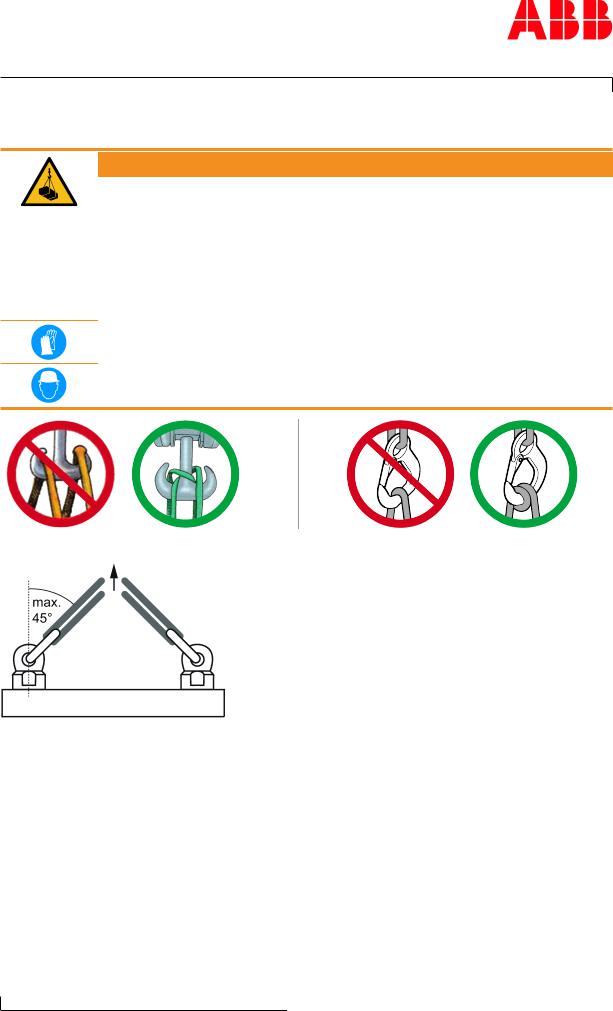
Page 8 / 16
Operation Manual / 2 Safety / TPS-R
1 Safety / 1.8 Lifting of loads
1.8Lifting of loads
 WARNING
WARNING
Suspended loads
Loads that are not attached according to regulations can cause injury to personnel or fatal accidents.
uLoads must always be fastened to properly functional lifting gear with a sufficient load limit.
uPay attention to the correct attachment of loads on the crane hook.
uPeople must not stand beneath suspended loads.
Wear safety gloves to protect against mechanical hazards.
Wear safety helmet.
Fig. 3: Attachment of loads on the crane hook
Fig. 4: Attachment angle
If there are two or more suspension points, the attachment angle of 45° must not be exceeded. This prevents excessive loading due to diagonal pull.
uBefore looping around the components of the turbocharger, let them cool down (maximum 80 °C).
uAttach components of the turbocharger as described in the respective action steps.
uUse a suitable edge guard if there are sharp edges.
uThe assembly devices must be completely screwed in and must not unscrew during use.
uUse assembly devices only for the described applications.
uPut down dismantled components of the turbocharger in such a way that they cannot tip over.
© Copyright 2018 ABB. All rights reserved. |
HZTL4027_EN |
Revision A |
April 2018 |
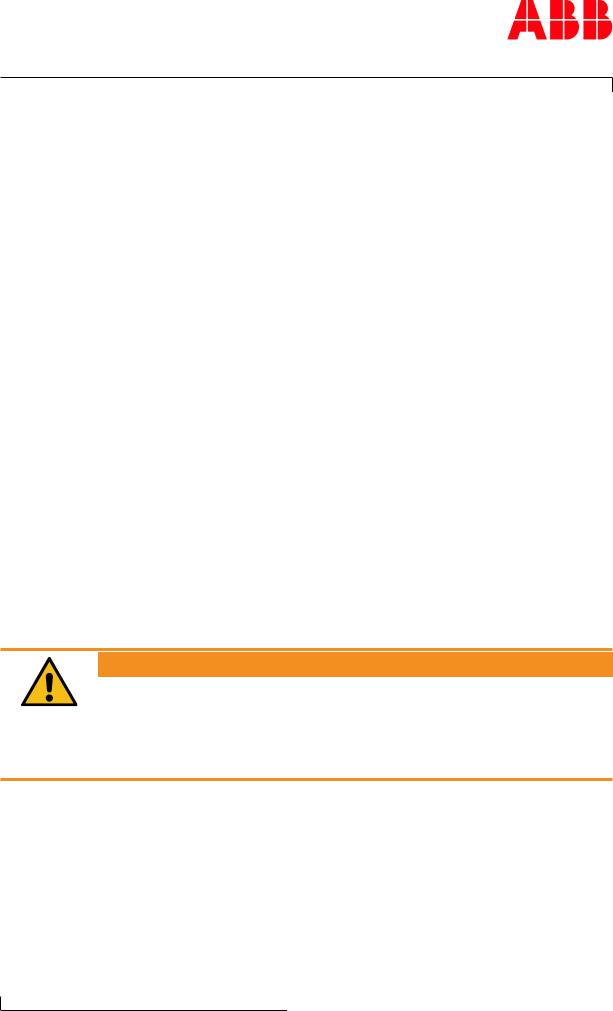
Operation Manual / 2 Safety / TPS-R
1 Safety / 1.9 Prerequisites for operation and maintenance
1.9Prerequisites for operation and maintenance
Responsibility of the operating company
In awareness of its responsibility, the operating company must ensure that only authorised
personnel work on the turbocharger, who:
¡Are versed in the general and locally applicable regulations for occupational safety and accident prevention
¡Are equipped with the prescribed personal protective equipment
¡Have read and understood the Operation Manual
¡Have been instructed in the use of the turbocharger.
The safety-conscious work of the personnel and adherence to the Operation Manual must be checked periodically.
Suitable working materials and personal protective equipment must be kept in a perfect condition.
Only authorised personnel may remain in the vicinity of the turbocharger when the engine is running.
Competence of personnel
The turbocharger must only be operated and serviced by trained and authorised personnel. Basic mechanical training is a prerequisite.
Modifications to the turbocharger
Modifications to the turbocharger must be approved by ABB Turbo Systems.
 WARNING
WARNING
Use original parts
Operation of the turbocharger with non-original parts can impair the safety of the turbocharger and can cause serious damage to property and injury to personnel.
u Only use original parts from ABB.
Original parts and accessories are specially designed for ABB turbochargers.
ABB accepts no liability for any damage resulting from the use of non-original parts and corresponding accessories.
Page 9 / 16
© Copyright 2018 ABB. All rights reserved. |
HZTL4027_EN |
Revision A |
April 2018 |
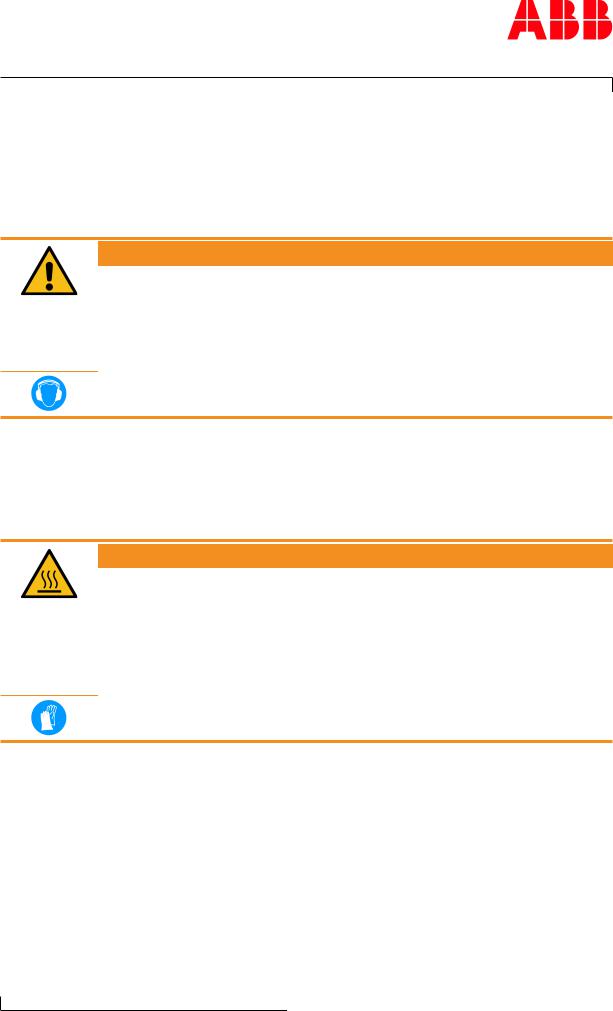
Page 10 / 16
Operation Manual / 2 Safety / TPS-R
1 Safety / 1.10 Hazards during operation and maintenance
1.10Hazards during operation and maintenance
Noise hazards
The turbocharger's noise emission is influenced by its installation and operating conditions. A noise level exceeding 85 dB(A) is harmful.
 WARNING
WARNING
Danger due to noise
Exposure to noise can harm the hearing system, impair health and the psychological state and may lead to lack of attention and irritation.
uWhen the engine is running, always wear ear protection.
uAlways wear ear protection if the sound pressure level exceeds 85 dB(A).
Wear ear protection.
Hazards due to hot surfaces
Surfaces of the turbocharger, attached parts and operating fluids (lubricating oil) get hot during operation. The surface temperature depends on the efficacy of the existing insulation. The temperature may rise to a level that can cause burns.
 WARNING
WARNING
Danger of burns
Touching hot surfaces or contact with hot operating fluids can cause burns.
uDo not touch hot surfaces. Observe the warning plate on the turbocharger.
uWear heat-resistant safety gloves and protective clothing.
uWait for the turbocharger to cool down before carrying out any work.
Wear safety gloves to protect against thermal hazards.
© Copyright 2018 ABB. All rights reserved. |
HZTL4027_EN |
Revision A |
April 2018 |
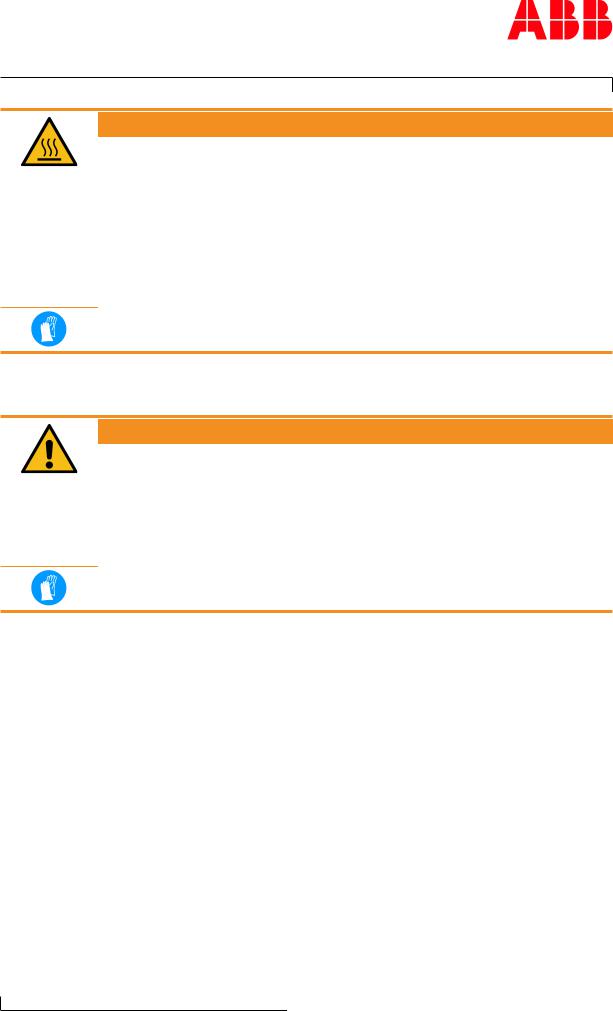
Operation Manual / 2 Safety / TPS-R
1 Safety / 1.10 Hazards during operation and maintenance
 WARNING
WARNING
Hot surfaces on a non-insulated turbocharger
Non-insulated turbochargers can cause serious injuries to personnel (burns).
The turbocharger is supplied with or without insulation in accordance with the purchase order received from the enginebuilder. If supply is without insulation, the enginebuilder is responsible for providing the turbocharger with proper insulation and for providing protection against contact with hot surfaces.
uCompliance with the instructions and specifications given by the enginebuilder to protect against hot turbocharger surfaces is compulsory.
Wear safety gloves to protect against thermal hazards.
Hazards due to rotating parts
 WARNING
WARNING
Physical hazards
Contact with rotating parts can cause severe injury. The turbocharger must never be used without the filter silencer or the air suction branch. With the engine stopped, the rotor can rotate due to the stack draught alone.
uOperate the turbocharger in compliance with the specifications.
uSecure the rotor against unintentional rotation during maintenance.
Wear safety gloves to protect against mechanical hazards.
Page 11 / 16
© Copyright 2018 ABB. All rights reserved. |
HZTL4027_EN |
Revision A |
April 2018 |
